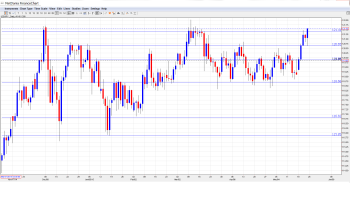USD/JPY rebounded last week with strong gains, as the yen lost over 200 points. The pair closed at 121.47. There are nine events this week. Here is an outlook on the major events moving the yen and an updated technical analysis for USD/JPY.
US housing numbers were mixed and manufacturing numbers slipped, but the FOMC minutes were optimistic in tone, as policymakers remain confident that Q2 will outperform a disappointing Q2. Over in Japan, Preliminary GDP beat the estimate, but this wasn’t enough to stop the yen’s slide.
[do action=”autoupdate” tag=”USDJPYUpdate”/]USD/JPY graph with support and resistance lines on it:
- Trade Balance: Sunday, 23:50. Trade Balance is closely linked to currency demand, as foreigners must purchase yen to buy Japanese exports. The indicator improved to 0.00 trillion yen in March, beating the estimate of -0.41 trillion. This marked the first time the country did not post a monthly trade deficit in over 4 years. Will the upswing continue in the April report?
- BOJ Monthly Report: Monday, 5:00. This minor indicator contains the BOJ’s analysis of economic conditions, as well as statistical data.
- SPPI: Monday, 23:50. This index measures corporate inflation and has been losing ground in the past few releases. The indicator dipped to 3.2% in March, within expectations.
- Monetary Policy Meeting Minutes: Tuesday, 23:50. Analysts keep close tabs on the BOJ’s minutes and will be looking for any hints regarding future policy interest rate policy. With the Japanese economy continuing to struggle, no surprises are expected from the minutes.
- Retail Sales: Wednesday, 23:50. Retail Sales is the primary gauge of consumer spending, and should be treated as a market-mover. The indicator looked awful in March, posting a sharp loss of 9.7%. This was considerably worse than the estimate of a 7.4% decline.
- Household Spending: Thursday, 23:30. Household Spending is a key indicator, as consumer spending is crucial for economic growth. The indicator plunged in March, coming in at -10.6%. Still, this beat the estimate of -11.7%. Will we see some improvement in the April release?
- Tokyo Core CPI: Thursday, 23:30. This is the primary gauge of consumer inflation, and an unexpected reading can affect the direction of USD/JPY. The index had been steady during 2015, with three straight readings of 2.2%. However, in the April report, the indicator managed just a weak gain of 0.4%.
- Preliminary Industrial Production: Thursday, 23:50. This important indicator provides a snapshot of the level of activity in the manufacturing sector. The indicator improved in May, but still posted a decline of 0.3%.
- Housing Starts: Friday, 5:00. In March, Housing Starts ended a streak of declines, posting a respectable gain of 0.7%. This easily beat the estimate of -1.8%.
* All times are GMT
USD/JPY Technical Analysis
USD/JPY started the week at 119.35 and touched a low of 119.34. It was all uphill from there, as the pair climbed all the way to 121.53, breaking support at 122.19 (discussed last week). The pair closed the week at 121.47.
Live chart of USD/JPY: [do action=”tradingviews” pair=”USDJPY” interval=”60″/]
Technical lines from top to bottom:
We start with resistance at 124.16. This line marked the start of a yen rally in June 2007, which saw USD/JPY drop to the 96 level.
123.11 marked the start of a lengthy yen rally in July 2007.
122.19 is the next resistance line.
121.39 was breached by the pair, which will start the week just above this line. It had held firm since mid-March.
120.65 was an important cap in January and February.
119.88 has strengthened in support, following strong gains by USD/JPY during the week.
118.68 has been busy in the month of May, but has some breathing room following the dollar rally.
The next support line is 117.94.
116.82 has remained intact since mid-January.
115.85 is the final support level for now.
I am bullish on USD/JPY
US numbers were not impressive last week, but the yen couldn’t take advantage as the pair moved back above the 120 level. The US economy is expected to improve in Q2, and the sharp divergence in monetary policy between the Federal Reserve and the BOJ could add to the yen’s woes.
In our latest podcast, we discuss commodity currencies, oil hedging and preview next week’s events.
Subscribe to Market Movers on iTunes
- For a broad view of all the week’s major events worldwide, read the USD outlook.
- For EUR/USD, check out the Euro to Dollar forecast.
- For the Japanese yen, read the USD/JPY forecast.
- For GBP/USD (cable), look into the British Pound forecast.
- For the Australian dollar (Aussie), check out the AUD to USD forecast.
- For the kiwi, see the NZDUSD forecast.

